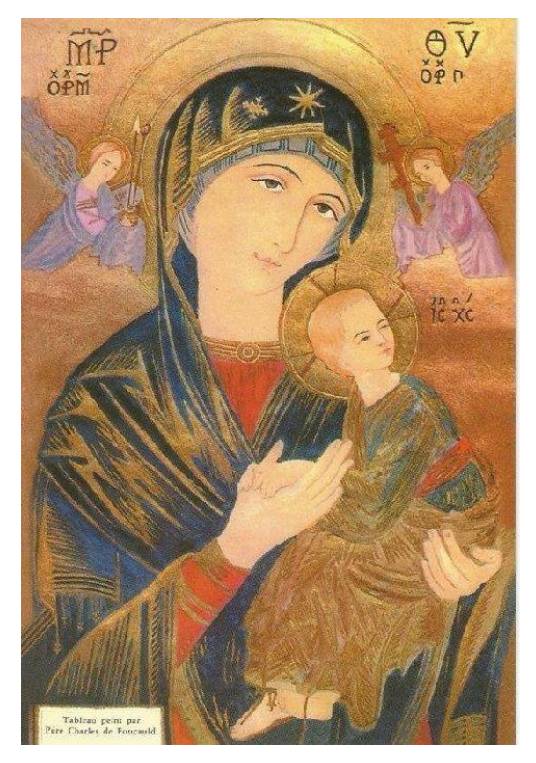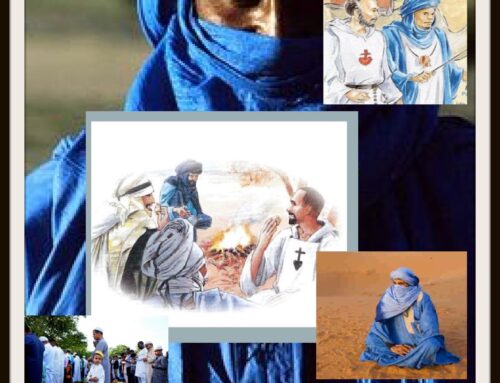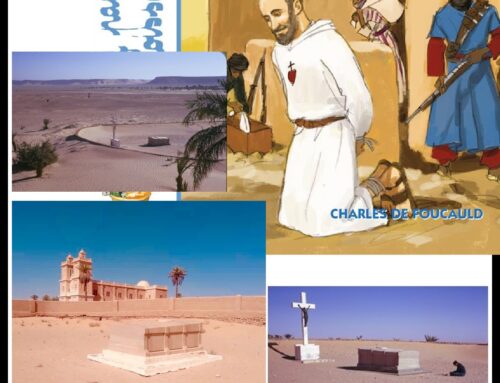At a time of great sorrow, shortly before Christmas 1893, not knowing where to turn, fearing to be deceived by the devil, I placed myself completely in Her arms. I remembered Her Mother’s Heart of Perpetual Help, and I placed myself in Her hands like a child, as Her property, begging Her, Our Lady of Perpetual Help, to carry me as She carried You when You were a child, and to do with me not what I would wish, but what She Herself would wish for the greater glory of Her Son, according to His Will.
– St Charles de Foucauld

Our Lady of Perpetual Help
This is the painting of Our Lady of Perpetual Help drawn by CHARLES DE FOUCAULD, from the original.
He prayed often to Her under this title and put his first fraternity under her care as the Mother of Perpetual Help. He wrote the following prayer in 1896.
(The original picture by Bl. Charles is kept in the little museum of the Poor Clare Nuns in in Nazareth.)
Blessed Charles de Foucauld and Our Lady of Perpetual Help
by Fr. Terrence Moran CSSR
The gospel speaks of the two great commandments – love of God and love of neighbor with one’s whole being – so I’d like to speak about Mary who surely is the great sign of the possibility for a human being to give herself to that kind of love so totally. I’d like to focus on the two titles of Mary that were dearest to Brother Charles – Our Lady of the Visitation and Our Lady of Perpetual Help.
Brother Charles wanted Our Lady of the Visitation to be the patron of each fraternity because she is the very model of the contemplative missionary. And your charism is missionary as is the Church itself. Louis Massignon once wrote to Brother Charles of the significance of the fact that Jews, Christians, and Muslims were united in having Abraham for a common father. Brother Charles responded that that past reality was not as significant as a future reality – that all people – Jews, Christians, and Muslims, find their common destiny and fulfillment in Jesus. As Teilhard de Chardin said, “we are all moving toward the One who is moving toward us.”
The Visitation on the surface is a very human reality – two women, one young, one older, finding mutual support in one another’s embrace. But the Visitation is something far more in the depths of the flesh of Mary and Elizabeth. The hidden presence of God is Mary stirs a wordless joy in the hidden child in the womb of Elizabeth. And this is the missionary way of Brother Charles and his followers: something hidden in you, or better Someone, will spark that same presence hidden in another. The presence is hidden, the process is hidden, often too, the results are hidden. But the mystery of the visitation gives you the courage to set out into the hill country again and again; to open your arms in embrace over and over.
Brother Charles first saw the image of Our Lady of Perpetual Help in the hands of his beloved grandmother in her coffin – a traumatic loss for him as a boy. It was the first church he always visited when he went to Rome – conveniently located near the Termini train station. It was the patronage of his first hermitage in Nazareth. He painted an icon of Our Lady of Perpetual Help – which was criticized because me made her eyes look Oriental – only Catholics could criticize making the image of a Palestinian woman look more Palestinian!
I’m sure you are familiar with the story which the icon portrays. Like the Visitation, the story on the surface is a very human one – the child Jesus is terrified by a vision of his future Passion – the angels carrying the Cross, the nails, the lance, the scourge, the crown of thorns – as he runs terrified into the arms of his mother. The most telling detail in the icon is that he loses his sandals in his flight; one is gone. The other hangs on by a strap to his bare foot. This is a calculated reference to the story of Moses and the encounter with God in the burning bush. Moses is told to remove his shoes because he stands on holy ground. In the OLPH icon it is God who loses his shoes because he does not want anything, not even a slip of leather, to be a protective barrier between God and human experience. God takes off God’s shoes to stand, bare foot and vulnerable, on the holy ground of human experience. The OLPH icon proclaims the breath taking radicality of the Incarnation. God experiences human natures to its depths – even the terror we feel in the face of the extinction of death. God wants to stand in reverence on the holy ground of human terror.
It was a perception of this radicality of the Incarnation that Little Sister Magdeleine, that great lover of the Child of Bethlehem and Nazareth, was expressing when she wrote her famous words, “Before being religious, be human and Christian in all the strength and beauty of these terms.” Too often religion and religious life can become that piece of leather that protects and defends us from the fullness of human experience in which the Son of God was pleased to immerse himself. Who of us could dare attempt such vulnerability, such nakedness? Only those who contemplate the vulnerability of Bethlehem, the nakedness of the Cross.
May Our Lady of Perpetual Help be your teacher of that contemplation. May Our Lady of the Visitation take you in her embrace.






